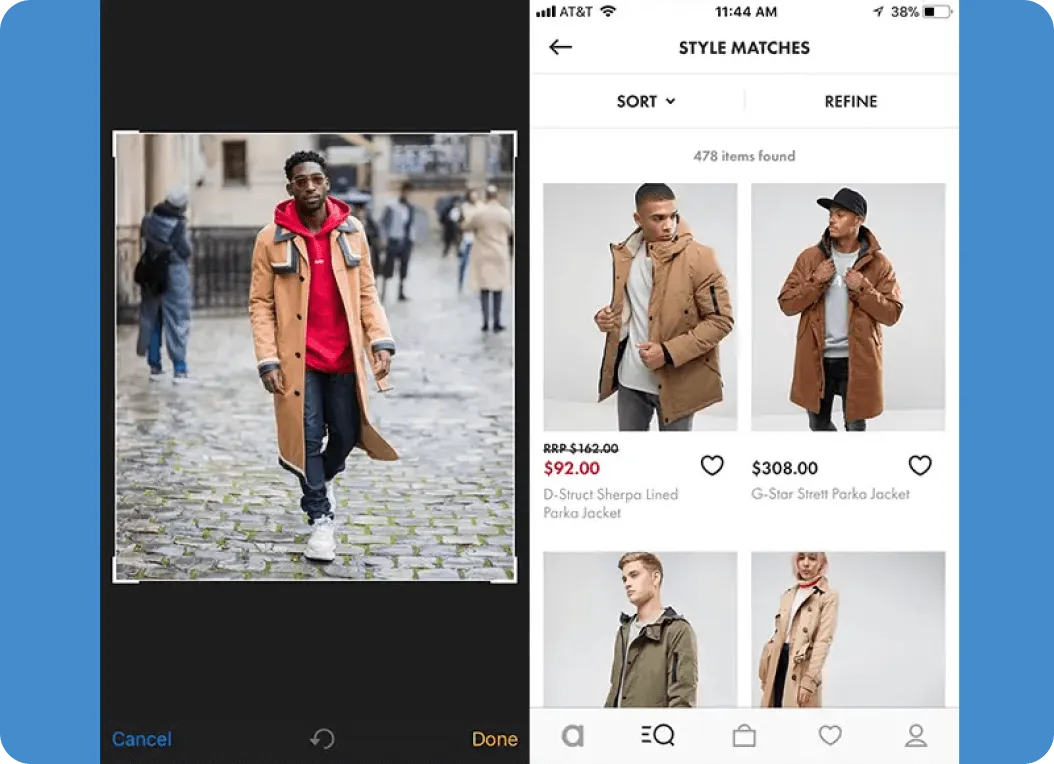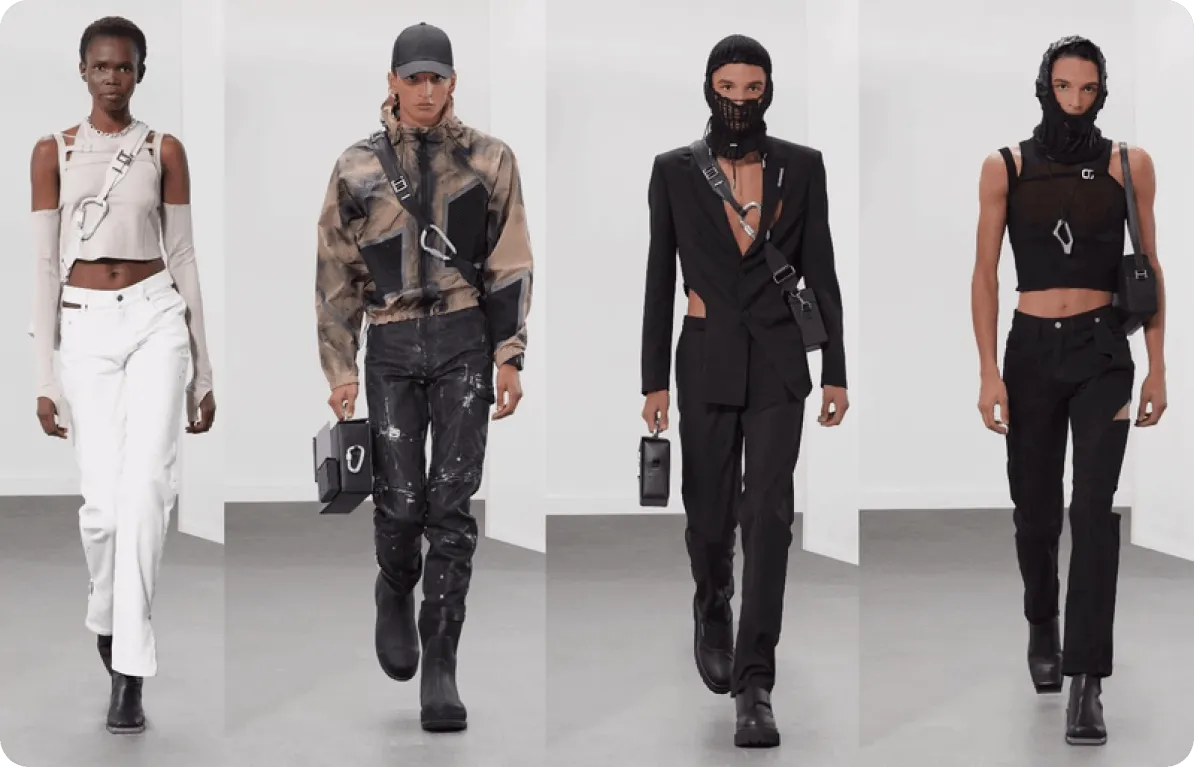اكتشف كيف يُحدث الذكاء الاصطناعي في تجارة الأزياء بالتجزئة ثورة في الصناعة من خلال التعرف المتقدم على الملابس المدعوم بالذكاء الاصطناعي وقدرات البحث المرئي المحسنة.

اكتشف كيف يُحدث الذكاء الاصطناعي في تجارة الأزياء بالتجزئة ثورة في الصناعة من خلال التعرف المتقدم على الملابس المدعوم بالذكاء الاصطناعي وقدرات البحث المرئي المحسنة.

في السنوات الأخيرة، بدأ الذكاء الاصطناعي (AI) في إظهار تأثيره في صناعة الأزياء. ما كان يعتمد بشكل أساسي على الحدس والعمليات اليدوية يدمج الآن تدريجيًا البيانات والخوارزميات. في حين أن هذا التحول لا يزال قيد التقدم، إلا أن الذكاء الاصطناعي بدأ يلعب دورًا متزايدًا في مجالات تتراوح من توصيات المنتجات إلى البحث المرئي.
ينعكس هذا التأثير في السوق العالمية للذكاء الاصطناعي في مجال الأزياء، والتي بلغت قيمتها 1.43 مليار دولار أمريكي في عام 2023، مع توقعات بنمو سريع، لتصل إلى 28.48 مليار دولار أمريكي بحلول عام 2032. في قلب هذا التغيير يكمن رؤية الحاسوب، وهو فرع من فروع الذكاء الاصطناعي يمكّن الآلات من التقاط وتحليل المدخلات المرئية من الصور ومقاطع الفيديو. يمكن بعد ذلك تفسير هذه البيانات واستخدامها لأتمتة العمليات وتبسيط سير العمليات داخل صناعة الأزياء.
من التنبؤ باتجاهات الموضة إلى تنظيم الملابس، يعمل الذكاء الاصطناعي على تعزيز الكفاءة مع إعادة تشكيل تجربة التسوق، مما يجعلها أكثر تخصيصًا وديناميكية وجاذبية للمستهلكين.
يُحدث الذكاء الاصطناعي طفرة في صناعة الأزياء، ويدفع الابتكار، ويوفر الوصول إلى رؤى جديدة، ويزيد من الدقة والكفاءة. من التعرف على الملابس إلى التنبؤ بالاتجاهات وتعزيز تجارب التسوق، يمكن للذكاء الاصطناعي أن يساعد في إعادة تشكيل كل جزء من تجربة البيع بالتجزئة للعميل. دعنا نلقي نظرة فاحصة على كيف يمكن للذكاء الاصطناعي أن يلعب دورًا رئيسيًا في صناعة الأزياء.
التطور الرئيسي في صناعة الأزياء هو التعرف الآلي على الملابس المدعوم بالذكاء الاصطناعي. بمساعدة رؤية الكمبيوتر، يمكن للذكاء الاصطناعي تحديد وتصنيف الملابس بدقة حسب النوع، بالإضافة إلى الأنماط والأنسجة والأنماط. هذا مفيد بشكل خاص للمصممين، الذين يمكنهم الاستفادة من قدرات التعرف على الأنماط في الذكاء الاصطناعي لدراسة التصميمات الحالية والعثور على إلهام جديد.
أبرزت الأبحاث فعالية الشبكات العصبية الالتفافية (CNNs) لهذه المهام، وعرضت كيف يمكن للذكاء الاصطناعي أداء تصنيف الملابس متعدد الفئات، والتعرف على السمات، وحتى اكتشاف الكائنات بدقة عالية. أظهر عملهم قدرة الذكاء الاصطناعي على تحسين التصنيف وإدارة المخزون من خلال مهام مثل التجزئة وخوارزميات اكتشاف الكائنات في البيع بالتجزئة، والتي تحدد عناصر ملابس معينة في الصور.
يعزز الذكاء الاصطناعي هذه العملية بمهام مثل مهاماكتشاف الكائنات والتجزئة. يمكن تدريب نماذج اكتشاف الكائنات مثل Ultralytics YOLOv8 لاكتشاف وتجزئة وتصنيف عناصر معينة من الملابس داخل الصور ومقاطع الفيديو، مما يساعد تجار التجزئة في إدارة البضائع والمخزون.

التجزئة، تأخذ الأمر خطوة أخرى إلى الأمام عن طريق تقسيم الصور إلى أجزاء متميزة، مثل فصل فستان عن الخلفية أو إبراز نمط معين. مع نماذج مثل YOLOv8، وأتمتة التعرف على الملابس، يمكن للذكاء الاصطناعي تحسين الكفاءة في صناعة الأزياء. من خلال أتمتة عملية التعرف على الملابس وتصنيفها، يمكن للعلامات التجارية تبسيط إدارة المخزون، وتحسين توصيات المنتجات للعملاء، وضمان وظائف بحث أسرع عن المنتجات في التجارة الإلكترونية. يساعد هذا المصممين على البقاء على اطلاع دائم بالاتجاهات وتفضيلات المستهلكين من خلال تحليل بيانات السوق في الوقت الفعلي، مما يسمح لهم بمواءمة تصميماتهم بشكل أكثر فعالية مع حركات الموضة الحالية.

يعيد الذكاء الاصطناعي أيضًا تشكيل منصات الأزياء للتجارة الإلكترونية، خاصة مع إدخال تقنية البحث المرئي. بدلاً من كتابة الكلمات الرئيسية، يمكن للعملاء الآن البحث عن المنتجات باستخدام الصور، وذلك بفضل رؤية الكمبيوتر المدعومة بالذكاء الاصطناعي. من خلال تحليل صورة أو لقطة شاشة، يمكن للذكاء الاصطناعي العثور على الفور على عناصر مماثلة داخل مخزون بائع التجزئة. هذا لا يجعل عملية البحث أسرع فحسب، بل أيضًا أكثر دقة، مما يساعد العملاء في العثور بسرعة على ما يبحثون عنه بالضبط. والنتيجة؟ تجربة تسوق أكثر سلاسة تعزز رضا العملاء وتزيد من معدلات التحويل، مما يؤدي إلى شراء المزيد من المنتجات لكل عميل.
تم تقديم مثال بارز على هذا التقدم في ورقة البحث "التوصية المرئية والبحث المرئي للتجارة الإلكترونية للأزياء". يوضح البحث كيف يمكن تحسين البحث المرئي باستخدام نماذج رؤية الكمبيوتر، مما يسمح للمستخدمين بتحميل الصور والاعتماد على نماذج اكتشاف الكائنات لتحديد والتوصية بعناصر ملابس مماثلة. يمكّن هذا النهج منصات التجارة الإلكترونية للأزياء من تقديم إمكانات بحث أكثر ديناميكية تعتمد على الصور، مما يساعد العملاء في العثور بسرعة على ما يبحثون عنه بالضبط، وتعزيز تجربة التسوق الشاملة.

تستخدم متاجر بيع الأزياء بالتجزئة البارزة هذه التقنية، بما في ذلك ASOS. تتيح ميزة Style Match من ASOS للعملاء العثور على المنتجات بنقرة سريعة واحدة. كل ما عليك فعله هو تحميل صورة وسيقوم التطبيق بالباقي، مما يساعدك في العثور على المنتج في الصورة، أو يوصي بشيء مشابه.

يجلب الذكاء الاصطناعي مستوى جديدًا من التطور إلى صناعة الأزياء، ويقدم العديد من الفوائد التي تتجاوز مجرد الأتمتة البسيطة. من خلال تسخير قوة الذكاء الاصطناعي، لا يستطيع تجار الأزياء بالتجزئة تعزيز عملياتهم فحسب، بل يمكنهم أيضًا إنشاء تجارب أكثر جاذبية وشخصية لعملائهم. دعنا نتعمق في بعض الفوائد الرئيسية التي يجلبها الذكاء الاصطناعي إلى عالم الأزياء.
يمكن للذكاء الاصطناعي أيضًا أن يلعب دورًا في تخصيص تجربة التسوق. من خلال تحليل تفضيلات العملاء الفردية وعادات التسوق، يمكن للذكاء الاصطناعي أن يوصي بالمنتجات التي من المرجح أن تلقى صدى لدى كل متسوق. على سبيل المثال، يستخدم تجار التجزئة مثل Zalando التعلم الآلي لتخصيص توصيات المنتجات بناءً على سجل التصفح وأنماط الشراء. يمكن لهذه الأنظمة توفير رسائل بريد إلكتروني مخصصة وعروض تسويقية مستهدفة، مما يعزز تجربة التسوق الشاملة.
إن تعزيز تجربة العملاء هذا باستخدام الذكاء الاصطناعي في مجال الأزياء يجعل العملاء يشعرون بالتقدير، ولكنه يزيد أيضًا من رضاهم وولائهم، مما يبني علاقات أقوى مع عملائهم.
لقد أثبت الذكاء الاصطناعي أنه محرك قوي للإيرادات في مجال بيع الأزياء بالتجزئة من خلال تخصيص توصيات وعروض المنتجات. تُظهر الأبحاث أن الشركات التي تتفوق في التخصيص المدفوع بالذكاء الاصطناعي تحقق إيرادات أكثر بنسبة 40٪ من هذه الأنشطة مقارنة باللاعبين المتوسطين. يتم تحقيق هذه الزيادة في الإيرادات من خلال تخصيص التوصيات والتجارب لتفضيلات العملاء الفردية، مما يؤدي إلى زيادة المشاركة ومعدلات التحويل.
في حين أن الذكاء الاصطناعي يجلب العديد من الفوائد لصناعة الأزياء، إلا أنه يأتي أيضًا مع مجموعة التحديات والعيوب الخاصة به. يعد فهم هذه التحديات أمرًا بالغ الأهمية لتنفيذ الذكاء الاصطناعي بشكل فعال في مجال الأزياء وضمان خدمته لكل من الصناعة وعملائها بشكل جيد. دعنا نستكشف بعض التحديات الرئيسية.
أحد التحديات الكبيرة في الذكاء الاصطناعي للتعرف على عناصر الملابس هو تنوع الأساليب والتصميمات والاختلافات الثقافية مثل الأزياء التقليدية والزي الديني. تدريب نماذج الذكاء الاصطناعي للتعرف على عناصر الموضة وتصنيفها بدقة عبر مثل هذا الطيف الواسع ليس بالأمر الهين.
الموضة إبداعية ومتغيرة باستمرار بطبيعتها، مما يجعل من الصعب على الذكاء الاصطناعي مواكبة التصميمات والاتجاهات والاختلافات الثقافية الجديدة. يجب تدريب نماذج الذكاء الاصطناعي على مجموعات بيانات واسعة ومتنوعة مع مراعاة اتجاهات الموضة الجديدة لضمان قدرتها على تحديد العناصر وتصنيفها بشكل صحيح. حتى مع التدريب المكثف، يمكن أن تغفل نماذج التعلم الآلي أحيانًا عن الاختلافات الدقيقة في الموضة مثل الاختلافات في النسيج والخياطة والأهمية الثقافية وعوامل أخرى مثل الملاءمة والأنماط وظلال الألوان، مما يؤدي إلى تصنيفات خاطئة أو تحيز.
هناك قلق كبير آخر يتمثل في خصوصية البيانات، خاصة عندما يتم استخدام الذكاء الاصطناعي في تجارب التسوق المخصصة. غالبًا ما تتطلب هذه التقنيات جمع وتحليل كميات كبيرة من بيانات العملاء، مما يثير تساؤلات حول كيفية تخزين هذه البيانات واستخدامها وحمايتها. على غرار ميزة ASOS Style Match التي تتطلب من العملاء تحميل صورهم الشخصية.
يزداد وعي المستهلكين بمخاوف الخصوصية، وأي إساءة استخدام للبيانات أو سوء التعامل معها يمكن أن يؤدي إلى فقدان الثقة والتحديات القانونية المحتملة. يجب على تجار الأزياء بالتجزئة التعامل مع هذه المخاوف بعناية، والتأكد من أن استخدامهم للذكاء الاصطناعي يتوافق مع لوائح حماية البيانات ويحترم خصوصية العملاء.
يحمل مستقبل الذكاء الاصطناعي في مجال الأزياء إمكانات لا تصدق، مع ظهور ابتكارات جديدة. مع استمرار تطور التكنولوجيا، سيلعب الذكاء الاصطناعي دورًا أكبر في كيفية تصميم الأزياء وإنتاجها وتجربتها من قبل المستهلكين. فيما يلي بعض المجالات المثيرة التي من المتوقع أن يحدث فيها الذكاء الاصطناعي تأثيرًا كبيرًا.
يعد تخصيص الأزياء المدعوم بالذكاء الاصطناعي مجالًا مثيرًا وسريع التطور حيث يسمح الذكاء الاصطناعي لعلامات الأزياء التجارية بتقديم ملابس مخصصة ومصممة حسب الطلب ومصممة لتفضيلات العملاء الفردية. تستفيد هذه الابتكارات من تكنولوجيا الذكاء الاصطناعي للتعرف على عناصر الموضة من أجل تحليل كميات هائلة من البيانات، مثل عمليات الشراء السابقة وأنماط التصفح وحتى نشاط وسائل التواصل الاجتماعي، للتنبؤ بالأنماط والألوان والأقمشة التي من المحتمل أن يفضلها العميل. نتيجة لذلك، يمكن للعلامات التجارية إنشاء عناصر أزياء مخصصة للغاية تلبي الأذواق والاحتياجات الفريدة لكل عميل.
علاوة على ذلك، يساهم التخصيص المدفوع بالذكاء الاصطناعي أيضًا في الاستدامة في صناعة الأزياء. من خلال تمكين الإنتاج حسب الطلب، يساعد الذكاء الاصطناعي في تقليل النفايات المرتبطة بالإفراط في الإنتاج والمخزون غير المباع. يسمح هذا النهج للعلامات التجارية بإدارة الموارد بكفاءة أكبر ويتماشى مع الطلب المتزايد على ممارسات الموضة المستدامة.
تخيل مستقبلًا يتم فيه إنشاء مجموعات الأزياء بأكملها بواسطة الذكاء الاصطناعي، مع الحد الأدنى من التدخل البشري. يمكن للذكاء الاصطناعي تحليل بيانات الموضة العالمية والاتجاهات الثقافية وحتى الحركات الاجتماعية لإنشاء تصميمات تتناسب مع روح العصر. يمكن تصميم المجموعات التي تم إنشاؤها بواسطة الذكاء الاصطناعي هذه لأسواق معينة أو حتى تفضيلات فردية، مما يوفر أزياء مخصصة للغاية على نطاق لم يكن ممكنًا من قبل. يمكن للمصممين التعاون مع الذكاء الاصطناعي، واستخدامه كأداة لدفع الحدود الإبداعية وتجربة أشكال ومواد جديدة.
في حين أن هذه الرؤية للمستقبل لا تزال في طور الظهور، إلا أن عددًا قليلاً من العلامات التجارية الرائدة تستكشف بالفعل هذه الاحتمالات. تقود شركات مثل Collina Strada و Heliot Emil زمام المبادرة، وتستخدم الذكاء الاصطناعي لإنشاء تصميمات مبتكرة من خلال تحليل المجموعات السابقة واتجاهات الموضة الأوسع.

بدأ الذكاء الاصطناعي يُحدث تأثيرًا ملحوظًا في صناعة الأزياء، خاصةً في مجالات مثل التعرّف على عناصر الموضة وتصنيفها، وتخصيص تجارب التسوق، وتحسين إمكانات البحث المرئي. تُظهر هذه التقنيات بوادر واعدة في زيادة الكفاءة وتعزيز الإبداع، مع توفير تفاعلات أكثر تخصيصًا مع العملاء. على الرغم من وضوح إمكانات الذكاء الاصطناعي، إلا أن تأثيره طويل المدى على صناعة الأزياء لا يزال قيد التطور، وستحدد التطورات المستقبلية كيفية استمراره في التأثير على هذا القطاع.
ومع ذلك، فإن رحلة دمج الذكاء الاصطناعي في مجال الأزياء لا تخلو من التحديات. فتنوّع أنماط الموضة، والحاجة إلى دقة النماذج، والمخاوف بشأن خصوصية البيانات، كلها عقبات كبيرة يجب على الصناعة التعامل معها بحذر. وعلى الرغم من هذه التحديات، تفوق الفوائد المحتملة العيوب إلى حد كبير، خاصةً مع استمرار تطور الذكاء الاصطناعي وتحسّنه.
بالنظر إلى المستقبل، يحمل الذكاء الاصطناعي إمكانيات أكثر إثارة لصناعة الأزياء. فمن المجموعات المولّدة بالذكاء الاصطناعي إلى ممارسات الأزياء المستدامة وتجارب التسوق المخصصة بالكامل، تعد الابتكارات في الأفق بدفع حدود ما يمكن أن تحققه الموضة. ومع ازدياد اندماج الذكاء الاصطناعي في مجال الأزياء، من الضروري البقاء على اطلاع دائم وتبني التغييرات التي يجلبها، حيث من المحتمل أن تشكل مستقبل كيفية تصميم الأزياء وإنتاجها وتجربتها.
هل أنت مهتم بالتعمق أكثر في الذكاء الاصطناعي؟ انضم إلى مجتمع Ultralytics! اطّلع على أحدث إنجازاتنا في مجال الذكاء الاصطناعي على مستودع GitHub الخاص بنا، واستكشف حلولنا المبتكرة في مختلف الصناعات مثل الزراعة و التصنيع. كن جزءًا من رحلتنا بينما نتعلم ونبتكر معًا!